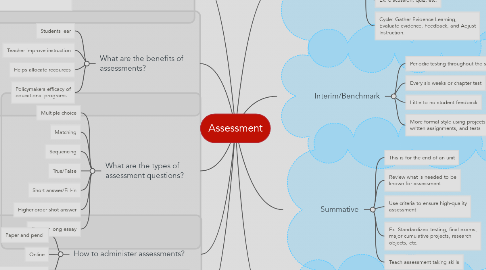Assessment
by Eduardo Barcenas


1. What is an assessment?
1.1. Shared process
1.2. Purposeful
1.3. Systematic measurement
1.4. Used to gather documentation, reflection, and improvement of learning and practices.
2. What are the benefits of assessments?
2.1. Students lear
2.2. Teacher improve instruction
2.3. Helps allocate recources
2.4. Policymakers efficacy of educational programs
3. What are the types of assessment questions?
3.1. Multiple choice
3.2. Matching
3.3. Sequencing
3.4. True/False
3.5. Short answer/Fill-in
3.6. Higher-order shot answer
3.7. Short or long essay
4. How to administer assessments?
4.1. Paper and pencil
4.2. Online
4.3. Computer adaptive testing
5. How to score assessments?
5.1. Human scoring
5.2. Distributed scoring
5.3. Automated scoring
5.4. Rubric
5.5. Checklist
6. Formative
6.1. Process of gathering evidence of student learning
6.2. Providing Feedback
6.3. Learners can change behaviors
6.4. Ex: discussion, quiz, etc.
6.5. Cycle: Gather Evidence Learning, Evaluate evidence, Feedback, and Adjust Instruction.
7. Summative
7.1. This is for the end of an unit
7.2. Review what is needed to be known for assessment
7.3. Use criteria to ensure high-quality assessment
7.4. Ex: Standardized testing, final exams, major cumulative projects, research objects, etc.
7.5. Teach assessment taking skills
8. Interim/Benchmark
8.1. Periodic testing throughout the school year
8.2. Every six weeks or chapter test
8.3. Little to no student feedback
8.4. More formal style using projects, written assignments, and tests
9. Other types of Assessments
9.1. Diagnostic
9.2. Performance
9.2.1. Individual groups, projects, portfolios, student logs, and journals.
